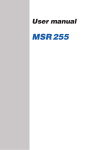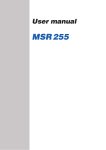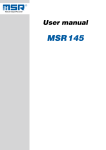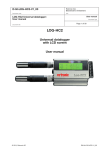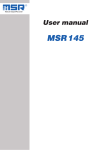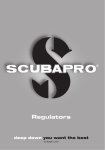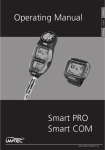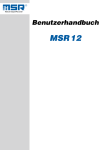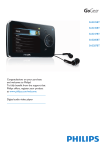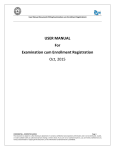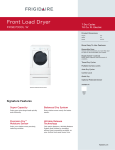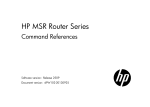Download MSR12 User manual
Transcript
User manual MSR 12 Instructions operating instructions Setup PC software Reader Setup Viewer Reader Other modules PC software Modules Online PC… Online Viewer Instructions Setup Reader Viewer Online PC… Contents . . . . . . . . . . . . . . . . . . . . . . . . . . . . . . . . . . . . . . . . . . . . . . . . . . 3 Important notes regarding this user manual . . . . . . . . . . . . . . . . . . . . . 4 Safety instructions and warnings . . . . . . . . . . . . . . . . . . . . . . . . . . . . . . 5 MSR 12 Modular Signal Recorder Operating Instructions . . . . . . . . . . 6 Overview . . . . . . . . . . . . . . . . . . . . . . . . . . . . . . . . . . . . . . . . . . . . . . . . . . 7 Controls . . . . . . . . . . . . . . . . . . . . . . . . . . . . . . . . . . . . . . . . . . . . . . . . . . 7 Connecting external sensors . . . . . . . . . . . . . . . . . . . . . . . . . . . . . . . . . . . 8 Turning the unit on . . . . . . . . . . . . . . . . . . . . . . . . . . . . . . . . . . . . . . . . . . . . 8 Selecting the main menu . . . . . . . . . . . . . . . . . . . . . . . . . . . . . . . . . . . . . . . 8 Displaying modules and sensors . . . . . . . . . . . . . . . . . . . . . . . . . . . . . . . . . 9 Displaying an online measurement . . . . . . . . . . . . . . . . . . . . . . . . . . . . . . . 10 Turning the online measurement mode on . . . . . . . . . . . . . . . . . . . . . 10 Adjusting the display mode . . . . . . . . . . . . . . . . . . . . . . . . . . . . . . . . . 10 Entering the sampling rate t . . . . . . . . . . . . . . . . . . . . . . . . . . 10 Entering the Y range . . . . . . . . . . . . . . . . . . . . . . . . . . . . . . . . 10 Entering the lowest value Ymin . . . . . . . . . . . . . . . . . . . . . . . . . 10 Selecting the graphical representation mode . . . . . . . . . . . . . . . . . . . 10 Rolling and Scrolling . . . . . . . . . . . . . . . . . . . . . . . . . . . . . . . . . . . . . . 10 Exiting the online measurement mode . . . . . . . . . . . . . . . . . . . . . . . . 10 Recording measurement parameters . . . . . . . . . . . . . . . . . . . . . . . . . . . . . 11 Starting data recording . . . . . . . . . . . . . . . . . . . . . . . . . . . . . . . . . . . . 11 Cancelling data recording . . . . . . . . . . . . . . . . . . . . . . . . . . . . . . . . . . 11 Notes on recording data . . . . . . . . . . . . . . . . . . . . . . . . . . . . . . . . . . . 11 Adjustments . . . . . . . . . . . . . . . . . . . . . . . . . . . . . . . . . . . . . . . . . . . . . . . . . 11 Measurement units . . . . . . . . . . . . . . . . . . . . . . . . . . . . . . . . . . . . . . . 11 Maintenance . . . . . . . . . . . . . . . . . . . . . . . . . . . . . . . . . . . . . . . . . . . . . . . . 12 User checks . . . . . . . . . . . . . . . . . . . . . . . . . . . . . . . . . . . . . . . . . . . . . 12 Cleaning . . . . . . . . . . . . . . . . . . . . . . . . . . . . . . . . . . . . . . . . . . . . . . . 12 Charging the battery . . . . . . . . . . . . . . . . . . . . . . . . . . . . . . . . . . . . . . 12 Battery and mains operation . . . . . . . . . . . . . . . . . . . . . . . . . . . . . . . . . . . . 13 Specifications . . . . . . . . . . . . . . . . . . . . . . . . . . . . . . . . . . . . . . . . . . . . . . . 13 Operating, transport and storage conditions . . . . . . . . . . . . . . . . . . . . . . . . 14 Troubleshooting . . . . . . . . . . . . . . . . . . . . . . . . . . . . . . . . . . . . . . . . . . . . . . 14 Packing list . . . . . . . . . . . . . . . . . . . . . . . . . . . . . . . . . . . . . . . . . . . . . . . . . 15 Warranty . . . . . . . . . . . . . . . . . . . . . . . . . . . . . . . . . . . . . . . . . . . . . . . . . . 15 Disposal . . . . . . . . . . . . . . . . . . . . . . . . . . . . . . . . . . . . . . . . . . . . . . . . . . . 15 MSR PC software . . . . . . . . . . . . . . . . . . . . . . . . . . . . . . . . . . . . . . . . . . . . 16 Setup . . . . . . . . . . . . . . . . . . . . . . . . . . . . . . . . . . . . . . . . . . . . . . . . . . 23 Reader . . . . . . . . . . . . . . . . . . . . . . . . . . . . . . . . . . . . . . . . . . . . . . . . 24 Viewer . . . . . . . . . . . . . . . . . . . . . . . . . . . . . . . . . . . . . . . . . . . . . . . . . 26 Online . . . . . . . . . . . . . . . . . . . . . . . . . . . . . . . . . . . . . . . . . . . . . . . . . 31 Other MSR PC software . . . . . . . . . . . . . . . . . . . . . . . . . . . . . . . . . . . 33 MSR 12-Modules . . . . . . . . . . . . . . . . . . . . . . . . . . . . . . . . . . . . . . . . . . . . 42 Modules Contents WARNING Indicates that equipment may suffer damage or that there is a risk of injury to the operator or user should the instructions not be followed correctly. CAUTION Indicates that equipment may suffer damage or that data loss may occur should the instructions not be followed correctly. Conventions Press the arrow keypad in the centre, without pressing the arrows. This functions as the Enter key. Press the arrow keypad in the centre. Setup Selected function Menu > Record > Start Select the Record function by pressing and , open the Record menu using , select Start and press . -> X See page X Viewer Press right arrow on the arrow keypad. Online Press the symbols on the arrow keypad in the direction shown. Reader Example Record -> 5 PC… Description Commands, menu items, functions, field names are shown in bold. •Reference to further information •Further information Modules Term / Symbol Commands, menu items, functions, field names Instructions In this manual notes of particular importance are presented as follows: Setup Important notes regarding this user manual •Before using the MSR 12 check the unit itself and all cables for visible signs of damage and never operate a damaged MSR 12. A damaged MSR 12 can endanger operator safety! Should the MSR 12 not function perfectly or appear to be damaged, send it to MSR Electronics GmbH for repair. •Ensure that no fluids enter the MSR 12's casing. Fluids cause corrosion damage and short-circuits inside the MSR 12. • The MSR 12 casing, sensors, cables and mains adapter must never be opened or modified. The manufacturer cannot be held liable for damage resulting from use other than that for which the unit is intended, or from improper operation of the unit. •Use only original MSR 12 sensors, cables and mains adapters. •Never use an MSR 12 with a leaking battery. Should a battery leak be detected ensure that the electrolyte does not come into contact with the skin, the eyes or the mouth. Should this occur, thoroughly rinse the affected area with water for at least 15 minutes. Consult a doctor. Do not breathe in any vapours emitted. Immediately clean the electrolyte from the MSR 12 using a soft cloth and dispose of the cloth subsequently. •Turn off the MSR 12 before connecting any plugs or sensors. •The mains voltage stated on the mains adapter must not be exceeded. •Observe the type plate on the mains adapter. •Ensure the proper disposal of an obsolete MSR 12, together with the cable and mains transformer ->15. Instructions Modules PC… CAUTION Setup •The MSR 12 is a unit for recording and displaying measurement parameters and may not be used for safety-related applications. Reader •Read the operating instructions carefully before using the MSR 12 or the MSR software. This will protect you personally and avoid damage to the unit. Viewer WARNING Online Safety instructions and warnings MSR 12 Instructions Operating Instructions The MSR 12 Modular Signal Recorder is a modular unit for measuring, displaying and recording various physical measurement parameters. Measurements may be carried out concurrently or using different measurement frequencies. Due to its modular design the MSR 12 can easily be customised by adding or replacing modules to provide the required functionality. Each module has a range of sensors – mostly of a similar type. For test purposes the gradient curve and the actual measurement parameters for the selected sensor may be shown on the unit's display. The readings are processed by the module's own processor and saved in the module’s memory. The base module of the MSR 12 includes a temperature sensor, a pressure sensor and three accelerometers (X, Y and Z-axes). A list of additional modules and sensors may be found at www. msr.ch. MSR 12 Mains adapter PC connection cable CD with MSR software Controls Instructions Overview Instructions Connecting external sensors Connect all the required sensors to the MSR 12 using the cables supplied. The MSR 12 only recognises sensors that are connected when the unit is switched on. Socket for sensors Turning the unit on Connect all the required sensors before turning on the MSR 12. Press down the on / off switch and wait until the MSR 12 display turns on: The following information appears on the display: On/off switch Software version Battery symbol, battery level Number of modules and sensors connected Current date Current time Memory available Recording on / off Using mains power Note: The MSR 12 automatically reverts to this display after 30 seconds idle time. Selecting the main menu Press after the unit has been turned on to open the main menu. The following instructions assume that the MSR 12 is displaying the main menu and that all sensors are connected. Pressing will return to the initial display that appears when the unit is turned on. Opens the selected menu item. Instructions Displaying modules and sensors Selecting the module Open the list of all available modules by pressing Modules (one module consists of several sensors, which are usually of the same type). Select the required module using and and open the list of sensors by pressing . Selected module Selecting the sensor to display Press and to select the sensor for which you wish to display measurement parameters and curves and confirm your selection by pressing . Note: The online display can be turned on by pressing Online . Menu Modules ACC x y z Selected sensor Instructions Displaying an online measurement In addition to recording measurement parameters to memory the MSR 12 can also display the reading and gradient across a sensor for test purposes. t Turning the online measurement mode on Turn the Online measurement function on by press- Y ing , select the desired sensor with and and adjust the display mode to your requirements. Ymin Adjusting the display mode Select the display mode using and . The display mode options can be changed by pressing and . •Entering the sampling rate t Select the display mode option t = … using and , then use and to set the sampling rate that you want to display. ACC x=-1.08 g Module name Sensor name Current reading Unit* *Can be changed via the MSR Setup. -> 10 •Entering the Y range Select the display mode option Y= … using and , then use and to set the range that you want the MSR 12 to display. •Entering the lowest value Ymin Select the display mode option Ymin= … using and , then change the value using and . Selecting the graphical representation mode The MSR 12 can display graphic curves in either Rolling or Scrolling mode. Rolling and Scrolling is accessed via Setup > Display . Select the required graphical representation mode and confirm by pressing . With the Scrolling option – in the style of a tradition-al data recorder – a “paper roll” is traced on the right-hand edge of the screen. The “paper” transits the display from right to left With the Rolling option the “trace” transits the display from left to right. Once it has reached the righthand edge it returns to the left and begins to overwrite the old curve. Exiting the online measurement mode Exit the online measurement mode by pressing The display returns to the main menu. . 10 Each module incorporated into the MSR 12 has its own dedicated memory in which the measurement parameters of the sensors attached to that module are recorded. Starting data recording (Record) From the main menu select Record > Start . During the recording process the green LED flashes. Cancelling data recording From the main menu select Record > Stop . Turning the MSR 12 off will also stop data recording. If the memory is full then this can also stop data from being recorded. See also ->14 (troubleshooting) Notes on recording data The data recording process is not affected by the status of the online display. Using the MSR PC Setup software (->23) it is possible to select the modules from the PC for which the MSR 12 is to record the measurement parameters. In addition, the frequency of measurement and recording can be set and the behaviour of the memory controlled. The measurement parameters can be transferred to a PC once the data recording process is complete (MSR PC software > Reader).(->24) Adjustments Measurement units The measurement unit of the selected sensor can be adjusted to suit requirements. From the main menu select Options , Units Select the required unit by pressing and . . The measurement unit set then applies to all similar sensors connected to the currently active module. Confirm your selection by pressing . 11 Instructions Recording measurement parameters User checks •Check the MSR 12 before each use. •Before using the MSR 12 check both the unit itself and all cables for visible signs of damage. •Check the functions of the MSR 12. •Never use an MSR 12 that is damaged or not functioning perfectly. Never use damaged accessories. •Ensure that the battery is sufficiently charged for the required period of use. Should the MSR 12 not function perfectly or should damage become apparent send the unit to MSR Electronics GmbH for repair. Repairs may only be carried out by MSR Electronics GmbH or an authorised dealer. Defective or damaged components may only be replaced with manufacturer’s original parts. Cleaning • Ensure that no fluids enter the MSR 12's casing. Fluids will cause corrosion damage and short circuits. •Never use corrosive or abrasive cleaning agents or polishes. •Cleaning agents containing additives such as alcohol will cause the case to become matt and/or brittle. CAUTION •Clean the MSR 12 when necessary. •Before cleaning, turn the unit off and disconnect it from the mains supply. •Use a cleaning agent suitable for plastic or a cloth dampened with water and soap. Charging the battery Before first use: The battery is not fully charged on delivery and should be charged for approx. 5 hours before using the MSR 12 for the first time. Use the mains adapter supplied and charge the MSR 12: •Before each use •When the battery level indicator shows •At least every two months Method: •Turn the MSR 12 off and remove the plugs for the sensor and the PC cable. •Connect the mains adapter to the MSR 12 and plug the adapter into a mains out-let. The yellow LED and the arrow next to the battery symbol indicate that the MSR 12 is using mains power. •Charging is complete when the battery symbol indicates full . •Unlock and unplug the mains adapter once charging is complete. Notes: •Please observe also the type plate on the mains adapter. •Recorded data is non-volatile and remains in the unit’s memory even when the battery is exhausted. 12 Instructions Maintenance The MSR 12 is powered by its built-in batteries. When charging the batteries, the mains adapter supplied is connected to the unit in place of the external sensors. WARNING For medical applications the MSR 12 may not be powered using the mains adapter. Using an optionally available plug, the unit may be powered by the mains adapter even when external sensors are attached. Specifications Size: MSR 12: (L x H x W) ca. approx. 137 x 74 x 27mm Connecting cable: approx. 50cm Weight: Power supply: MSR 12: approx. 180g Battery*: 3.6 V 880mAh NiMH Backup battery*: 3.0 V LiMn Battery life (unit turned off): approx. 2 months *Not user replaceable. Classification: Class III equipment For information relating to the modules and sensor specifications, please refer to the module chapter. 13 Instructions Battery and mains operation • Protect the MSR 12 from excessive exposure to the sun and other sources of heat. Avoid heavy impacts. • Do not place heavy objects on top of the MSR 12. • Only store the MSR 12 in a dry, dust-free environment. • Operating temperature: 0 °C to 50 °C • Storage temperature: -20 °C to 70 °C • Avoid contact with water and moisture. • Relative humidity: 30% to 95% max. (Storage and transport 10-95%). Troubleshooting Problem Possible cause Possible solution Data recording stops automatically The memory of at least one module is full. •Back-up data. •Check the overwrite mode and measurement frequency of all modules (MSR PC software ->Setup). ->23 “No channel” appears on the MSR 12 display. •MSR 12 does not recognise the sensors. •Check the sensor’s connections •Turn the MSR 12 off and back on again. 14 Instructions Operating, transport and storage conditions •MSR •User manual Options: •Mains adapter •MSR RS232 cable •Warranty card •MSR PC software Instructions Packing list •Protective case •Additional sensors •Adapter for connecting further sensors •RS232-USB converter •RS232 optical coupler Warranty See warranty card. Disposal Take the MSR 12 to a municipal waste disposal centre or return it to MSR Electronics GmbH. The MSR 12 must not be disposed of in normal domestic waste. 15 Setup PC software Reader Setup Viewer Reader Online Viewer Online PC software PC… Other 16 PC software PC… Version number of MSR CD Reader Insert the CD containing the MSR PC software into the computer’s CD-ROM drive. The installation procedure starts automatically*. During installation select: Run MSR Modular Signal Recorder now. appears on screen. The MSR symbol If the PC is not set up for automatic installation, proceed as follows: 1. Click Start > Run 2. Click Find > Look in: (set to CD drive). 3. Select the file Install_MSR.exe and Open. 4. In the Run dialog box click OK. 5. The installation process will begin. 6. Follow the instructions and select: Run MSR Modular Signal Recorder now. or 7. The MSR software may be started by clicking on the MSR symbol via Start > Programs > MSR > MSR. Viewer Installation of the MSR PC software on a PC Online External processing of MSR 12 data is carried out using the MSR PC software programs Setup, Reader, Viewer and Online. The MSR PC programs can be used for all MSR types. The Setup enables the properties of the MSR 12 and attached modules to be customised to user’s requirements. The Reader allows the user to transfer measurement parameters to a Windows PC. The Viewer is used to display data graphically or in table form or to exportit as a text file (*.csv). With the help of Online users can view measurement parameters and curves “live” on a PC. Setup Overview Version numbers of MSR PC programs MSR program window *The program "Inno Setup" for installing the MSR PC programs was written by Jordan Russell (www.jrsoftware.org, copyright Jordan Russell). 17 Uninstalling The software is uninstalled via the computer’s operating system (Programs > MSR > Uninstall MSR). System Requirements PC… Online Viewer Reader Setup •Windows 95 or higher •Serial port RS 232 or USB port with RS 232 converter 18 Preparation •Enter the path to the directory. •See following page for template. •Customer-specific programs *This window will appear if a connection to an MSR cannot be established using the current rule. Loader Dialog 19 PC… MSR program window Online •Select the required language. Reader •Select the port used by Reader, Online and Setup. Viewer •Before first use: Using open the MSR program window, select Settings > MSR. • Select the rule by which the Setup, Reader, Online and Format programs are to search for the required MSR*. Default: Search and use first MSR. Setup Before using the MSR PC programs Setup, Reader and Online, the following preparations must be completed: •Use the connecting cable to connect the MSR 12 with the PC (serial port). •Switch the MSR 12 on. • Ensure that the MSR 12 is not recording any measurement parameters (Record > Stop) during data transfer (Reader, Setup). Template Reader PC… Online 1.Assign right hand axis and blue colour shades to temperature in Viewer. 2.Save as template (Bluetemp.mse). 3.Generate new templates for Reader and Online: Select MSR program window, Settings MSR > Template , enter new name and path (Temperature.mse), then Open. 4.Open the still blank template (Temperature.mse) using . 5.Import the template that was created in Viewer (Bluetemp.mse). Select the required sensors (tick in checkbox) in the Module column and confirm with Accept. 6.Edit the displayed list: First select a sensor in the Module column and then choose Edit. 7.Change the name “HUM, T1” to “Outside temperature”, and Accept. 8.Continue to make the necessary adjustments and confirm them with Accept. Viewer Example The temperature curves are required to be blue and oriented on the right hand axis in all display modes. Setup The template, selected via Setting > MSR (*.mse), defines which sensors the Reader reads out as standard or are displayed in Online. The template sets the colour of the trace, the positioning of its axis (left, right) and gives the sensors a name (“HUM, T1” is required to be displayed as “outside temperature”, for example). Templates can be produced on the basis of examples contained in Viewer (->26). 20 Pre-adjustments - Reader Enter the required options for the Reader** via Settings > Reader. **Data records are transferred from the MSR 12 to a PC using the Reader. User defines which records are transferred to the PC, their filenames and their location. Online Once the data has been transferred to the PC various options are available to the user. Details may be found in the text window. Reader User defines which records are transferred to the PC. Viewer Transfer only the most recent data record logged with the MSR 12 to the PC. Setup Once data transfer is complete the Reader creates a data record (*.msr) from each logged record, names it and saves it in the corresponding directory. The bottom-most option allows the user to alter the suggested filename and location. PC… •Example "Automatically generate a text file" In addition to the MSR format file, the Reader creates a text file (*.csv), which can be opened with programs such as e.g. Microsoft Word or Excel. 21 Pre-adjustments - Online •Select the desired frequency with which measured parameters are to be transferred to the PC. •Once Online is started the measured para- meters of all available sensors are displayed onscreen. Upon exiting Settings (Einstellungen) the PC saves the settings that were last entered. The default settings can be reinstated by selecting Settings > MSR > Default. Once entry of the settings is complete, select Programs and start the required program. The following instructions assume that the preparations for using the MSR PC programs have been completed. PC… Note: Online Completion of the preparatory measures Viewer Reader •Online can be used as a server. This allows the measurement parameters to be accessed across a network. Setup Enter the required options for Online* via Settings > Online. * Online allows the user to view the progress of the measurement process directly on-screen and to save recorded parameters on the PC. 22 From a PC, Setup is used to select the modules for which the MSR 12 is required to save measurement parameters, to enter the measurement frequency, modify sensor and module names and to set the behaviour of the MSR’s memory. •Complete the preparations (->19). •Start Setup (Setup symbol) •Use Read to access the configuration saved in the MSR 12. The BASE configuration screen then appears on the monitor. Further configuration screens can be selected by clicking on the tabs. The Configuration* display appears on the MSR 12. Setup Setup A section of the BASE configuration screen Each of the MSR 12’s modules has its own configuration screen. The modules BASE, BCOM, ACC3 and PR3 together with their respective sensors are MSR 12 standard components. •Select the configuration screen requiring modification and make the required changes. Further information on the configuration screens may be found in the Module chapter ->42. •Transfer the new configuration to the MSR 12 with Write. The main menu appears on the MSR 12’s display. •If Start recording automatically upon power on has been selected in Setup (BASE configuration screen), the following window appears: Yes: The configuration is transferred to the MSR 12. Recording then starts. To cancel: See Module > BASE ->43 No: The configuration is transferred to the MSR 12. Recording is not started. Cancel: Stops configuration transfer. *Configuration remains visible on the display until the configuration is transferred to the MSR 12 with Write or the MSR 12 is turned off. 23 Reader With the Reader users can selectively transfer data records logged with the MSR 12 to a PC. The transfer process does not delete any measurement records saved on the MSR 12. Transferring data records to a PC •Complete the preparations (->19). •Start the Reader (Reader symbol) Once data transfer has started (Start) all data records saved on the MSR 12 can be over- written if required (circular buffer). •Begin data transfer with Start. (In the case of protected data records the password* must first be entered.) The Read Data display appears on the MSR 12. The options selected under Settings > Reader (->21) influence the next steps: •Under the option Read selected records the following data entry dialog box appears: •Select the data records to be transferred and the corresponding module. ->25 • Click OK. ->25 •With the option Read selected records and save with “Save dialog as” under Settings > Reader (->21) the filenames and locations suggested by Reader can be overwritten. Once the data records have been saved on the PC a list of files created appears. Serial number Date (YYMMDD) Recording start time (HHMMSS) Copy number Filenames allocated by the Reader *Forgotten your password? See Format ->35. 24 Reader CAUTION More on the selective list 3 of the 4 modules of the record are transferred to the PC. Modify the selection with: Show record details t OK The modules of this record have the same start time. t The modules of this record have different start times. Reader 3/4 Number of recorded pages (record size) 25 Viewer Records created in Reader or Online may be viewed and edited on a PC with the Viewer. The measurement parameters may be displayed either in graph or in table form. •Start the Viewer (Viewer symbol). •Open a record (*.msr) via File > Open. Switch between graphs, tables and configuration Cross-hair on / off Lock axis Text created using the text mode Gridlines Autoscaling Undo last change Text mode Shift between text tool and graphics mode Viewer Traces on / off X-axis = time (seconds) Difference between cross-hairs 1 & 2 X and Y values: Cross-hair 1, cross-hair 2 (The displayed Y value always relates to the left-hand axis) Move traces Enlarge section Cross-hair With right mouse button held down. Move axis: Move centre: Mark the required section with the left mouse button held down. See also Graphics > Fixed axis. Grab the axis, move with left mouse button. Grab the centre, move with left mouse button. 26 File The File menu is used to Open records , to Reopen (Open again) the most recently used records and to Save the currently open record as displayed . With Save time window as the measurement parameters of the displayed time window are saved. (The measurement parameters of the hidden traces are also saved). For further options see Cutter ->34. Templates help to standardise the displays, enable easy repetition when reselecting the same sensors and the same printing format. Creating templates: Adjust the display with Graph and Configuration and save via File > Save as template (file type: *.mse). Export Time window as text exports the measurement parameters of the displayed time window in *.csv format. The measurement parameters of the hidden traces are also exported. The trace can be exported in Bitmap (*. bmp) or as JPEG format. Print preview opens a preview of the trace/graph. Print opens the print dialog box. Exit closes the Viewer. If changes were made the user is asked whether the changes should be saved. Note: The program saves changes as “Template” (*. mse). The template is automatically saved in the record’s directory. Template (*. mse) and record (*. msr) have the same name. Upon Opening a record the Viewer searches for the template associated with that record. Should the template not be located in the same directory as the record then the standard format will be opened. 27 Viewer Apply a template to the displayed record: File > Use template then select the required template (*mse). View The View menu allows measurement parameters to be displayed as a Graph or Table . Alternatively, using Configuration the display method can be customised to the user’s requirements. Graph Gridlines can be shown for each axis (bottom, left, right). •Select the required section with the left mouse button held down. The section is displayed enlarged. •For closer viewing, lock the time window ( ) or range of values to the left or right axis ( / ). Several axes can be locked. •With the left mouse button held down, select the required detail. The enlargement is displayed without altering the time segment or range of values of the locked axes. A further click releases the lock. Auto scal clears all locked axes. Using the two Crosshairs values can be measured on the X and Y traces. X and Y differences can be evaluated with the second cross-hair. The Y values displayed are always associated with the left axis. With Detailed legend traces can be turned on and off in the list of sensors. The complete record is displayed by selecting Auto scale . Auto scale clears all locked axes. Undo undoes the last enlargement. As long as the Configuration dialog is not quitted, Undo allows the last changes made to the displayed configuration screen to be undone. 28 Viewer Fixed axis simplifies the amount of detail shown within a time window or range of values. Table (Tabelle) Go to time allows users to jump straight to the line in the table with the required time. Jump to beginning of graph causes the table to jump to the first measurement values displayed in the graph. Configuration As long as the Configuration dialog is not quitted, Undo allows the last changes made to the configuration screen to be undone. Text mode Using the text mode you can insert texts at any place. you can activate and deactivate By clicking on the text mode. Delete text: •Click on . The viewer displays "Text 1" in the upper left corner. •Drag the text field to the desired place. •Double click on the text field and enter your required text. •Click with the right mouse button on the text field and select Delete. Text field with X and Y values: •place the crosshairs (->26) on your chosen position to adoddopt the X and Y values you would like to use in the text field. •Create a text field (see above) and click on the right mouse button. Select the desired representation. 29 Viewer Insert text: Configuration allows the display method of the measurement parameters to be set with the help of the configuration screens. Entering title and footer information is achieved via Configuration > General. The associated sensor name, assignment to the left or right axis, the colour, line weight and style can be set for each curve. Axis > inactive allows the graph curve to be shown or hidden as required. CAUTION Using Configuration >Time axis X, the time axis can be annotated, the time segment to be displayed can be set, and the Increment for the lettering and ruled lines, together with the Format for numbers can be entered. Automatic axis annotation with an Increment of 0 (zero). The number Format for the displayed X and Y values is entered via Configuration > Crosshairs. The displayed Y value always relates to the left axis. As long as Configuration is not quitted, users can undo the last changes made to the displayed configuration screen with . Quit Configuration via Graph or Table . Upon quitting, the Viewer saves the configuration. 30 Viewer Depiction of the curves using points (Configuration > Points/Curves > Yes) requires more computing power, possibly leading to problems. Online Online allows users to view the progress of the measurement parameters directly on-screen and save the logged values on a PC. Saved records can be opened and edited using the Viewer. Procedure: •Complete the preparations ->19. •Start Online (Online symbol). •Select the sensors for which the measurement parameters are to be transferred to the PC and displayed on-screen. •Upon clicking Next the measurement parameters are presented graphically and numerically. Online Turn trace on and off Exit Online Back to sensor selection The MSR 12 is not currently recording measurement parameters (MSR 12: Record > Stop). Pauses the transmission of measured parameters. With Continue, transmission is resumed. 31 For recurring applications in Online, Templates assist in selecting the required sensors and adjusting the display to suit. Create template: Start Online and select the required sensors. Select Next. With Graph > Properties and Graph > Gridlines, change the display properties of the traces. Via Back return to the trace display. Interrupt recording with Stop. Save the template via File > Save as template. Apply the template to Online: File > Use template and select the required template (*mse). Once recording has finished by clicking on Stop, the recorded measurement parameters and traces can be deleted via Clear. The display properties can be changed via Properties and Gridline. Select the frequency (Refresh rate) with which measurement parameters are to be transferred to the PC. Notes •The MSR’s arrow keypad is locked during data transmission and for 10 seconds thereafter. •Online may also be used while the MSR 12 is recording measurement parameters. •Measurement parameters can be polled via a server in Online. 32 Online Once recording has finished by clicking on Stop, the recorded measurement parameters can be saved via File > Save as. CSV The CSV utility creates text files (*.csv) from data records (*.msr). These may subsequently be opened and edited in a word processing or spreadsheet application. Creating a text file •Start CSV (MSR Program window > Tools > Csv). •Click on Start and select the data record from which the text file is to be created. CSV creates a text file (*.csv) and saves it in the corresponding directory for that data record. Text file (*.csv) and data record (*.msr) have the same name. Note: If a template (*.mse) exists for the data record in question, CSV takes this into account when creating the text file. Example: Opening a CSV text file with Excel •Start the word-processing or spreadsheet program. •Open the CSV file via File > Open. •Under File type , select Text Files. Data source MSR 12 name Serial number MSR 12 revision number Measured parameters (data) in chronological order Excel file with measured data Time of recording 33 PC… Record start time: Date (Day.Month.Year) and time of day (Hr: Min:Sec) Modules for which measurement parameters were recorded Module version Channel and sensor names Unit for the displayed value Cutter The Cutter utility creates an extract from a data record (*.msr). Creating an extract from a data record •Start the Cutter utility (MSR Program window > Tools > Cutter). •Click on Start and select the data record from which the extract is to be created. •Select the time window. Beginning / End. •Select the sensors for which the measurement parameters are to be exported to a new data record and click Next. PC… •Enter the name and directory for the new data record. Click on Save. 34 Format CAUTION Format deletes all data records saved in the MSR 12 and the password! Format deletes all data records saved in the MSR 12. Setup settings are not deleted. •If it is certain that all data records saved in the MSR, together with the password, are to be deleted, select Start. 35 PC… Delete all data records saved in the MSR 12 and the password •Start Format (MSR Program window > Tools > Format). •Connect the MSR 12 with the PC using the connecting cable (serial port). •Switch the MSR 12 on. •Ensure that the MSR 12 is not recording any measurements during the deletion process (Record > Stop). •Click Start. •Read the caution messages. Calc With Calc curves from existing data records can be linked to each other using formulae and saved as a data record (*.msr). The saved data record can be displayed and processed in the form of curves or as a table using the Viewer. Templates simplify the processing of recurring tasks. Computing new curves •Start Calc (MSR program window > Tools > Calc) Open data record 2 1 4 3 Enter formula 1 Open data record (data origin) Click on Open to open the data record for which you want to perform calculations on the curve. It is possible to open multiple data records. 2 Create new curves From imported curves select the curve that you want to use for your calculations and drag it – with the left mouse button pressed – to the right into the field for curves to be plotted. Repeat this procedure until the required number of curves is shown on the right. 3 formula Enter Enter the formula to be used for the new curve into the Formula column. For this, use the capital letters on the left. Example for a subtraction: A-C You will find a list of the available functions at the end of this section or under Help. Modify the text for the new curves The entries in the columns Module, Sensor and Unit can be modified. PC… Number field 36 Modify the order of the new curves With the left mouse button pressed, drag the number field to the required position. Delete new curves Click inside the number field of the curve to be deleted and then press the delete key. Via Template > Delete plotted curve, all new curves can be simultaneously deleted. Note: and saving the new curves Calculating Click on Calculate then enter the name and set the directory for the new data record. Click on Save. The curves are saved as data records (*.mrs). The saved measurement parameters can be displayed and processed as a curve or as a table by the Viewer. Intermediate values are interpolated. Only curves that overlap timewise can be calculated. Creating a template for processing recurring tasks Once you have created the new curves you can save their labels and formulae as a template (*.mse). (Template > Write). Creating new curves using templates Open the required template (*mse) via Template > Read. This will automatically generate a number of new curves. Multiple templates may be used to generate new curves. Each template generates a number of new curves. PC… 4 37 Operators / brackets + - * / ^ Plus, minus, multiply, divide, to the power of ( ) Open brackets, close brackets sqrt(no.) Square root of the number ln(no.) Natural logarithm of the number (base e) exp(no.) Raise basis e to the power of the number abs(no.) Absolute value of the number sgn(no.) no. >0: sgn = 1 no. =0: sgn = 0 no. <0: sgn = -1 cos(no.) Cosine of the number sin(no.) Sine of the number tan(no.) Tangent of the number ctg(no.) Cotangent of the number arcsin(no.) Arc sine of the number arccos(no.) Arc cosine of the number arctan(no.) Arc tangent of the number arcctan(no.) Arc cotangent of the number sinh(no.) Hyperbolic sine of the number cosh(no.) Hyperbolic cosine of the number tangh(no.) Hyperbolic tangent of the number ctgh(no.) Hyperbolic cotangent of the number toggleSgn(no.) Changes every second measurement parameter sign (plus/minus) PC… Functions Further functions on request 38 Concat With Concat (concatenate = to link) data records can be linked together and saved as a new data record (*.msr). The newly created data record can be displayed and processed in the form of curves or as a table using the Viewer. p Data record1 T0 p Data record2 T1 T2 Before concatenation Time T0 NewDatarecord3 T1 T2 Time After concatenation Concatenating several data records Start Concat (MSR program window > Tools > Concat) List of data records to be concatenated 1 2 3 Number window Status window 1 Select the data records to be concatenated Open the data records that you want to concatenate by clicking Add. Note that the list must be in chronological order such that the oldest data record is at the top. Therefore either open the oldest data record first or sort the list afterwards (see below). Sort the list alphabetically Use Sort to sort the list alphabetically. Data records that have automatically generated filenames (->21) can be chronologically sorted using Sort. PC… Modify the data record order With the left mouse button pressed, drag the number field to the required position. 39 Delete all data records from the list Use Delete all to remove all data records from the list. Delete one data record from the list Select the data record to be deleted and click Delete line. 2 Enter the name and directory for the new data record Set the path to the directory using Browse and enter the filename, or use the input window to do this. 3 Calculating the new data record Start the calculation process with Start. Cancel the calculation with Stop. p Note: Newdatarecord3 •Concat creates a straight line between the last data record of the first curve (T1) and the first data record of the second curve (T2). T0 T1 T2 Time StraightlinecreatedbyConcat •If, for the data records to be concatenated, there are curves that overlap timewise and these have p the same name (same module and sensor names with the same units), the calculation will be aborted and a corresponding message* will appear in the status window. •If the module names, sensor names or units of the curves to be concatenated do not correspond Concat will be unable to join the curves and will create two curves.** •With Concat you can superimpose curves with different module or sensor names. p Sensorp1 Sensorp2 Differentsensor names p Time p1 p1 Overlapping Time Sensorp1 Sensorp2 Newdatarecord Time p p Differentsensor Time namesand starttimes *Remove overlap Use the Cut utility to create an excerpt from a p data record that does not overlap timewise with the next data record. Newdatarecord Time PC… p1 p1 Removeoverlap Time **Modify module names, sensor names and units Use the Calc utility to match the module names, sensor names and units for the curves. 40 Output Manager PC… The Output Manager is currently not available. 41 Modules A selection of sensors – mostly of the same type – is attached to each module. Signals from these sensors are converted into measurement parameters by the module’s on-board processors and saved in the module’s memory. The modules BASE and BCOM have no sensors. The following modules and sensors are part of the MSR’s standard hardware: Module name Measured parameters / function BASE Saves the setup parameters and measurement behaviour of the MSR BCOM PC/MSR 12 communication module, capacity display PR3 Ambient air pressure and temperature (See page 45 for more details) ACC3 Acceleration in the X, Y and Z axes (See page 47 for more details) By adding modules, the MSR 12 can be adapted to record a variety of different parameters. A list of modules and sensors may be found at www.msr.ch. Each of the MSR’s modules has its own configuration screen with which users can customise the module’s behaviour to their exact requirements. The way in which configuration screens are displayed and modified is explained in the Setup chapter. Modules The following pages describe the modules and their configuration screens. 42 BASE standard module The standard module is incorporated into each MSR 12. It stores the parameters for Setup and the measurement performance settings of the MSR 12. BASE configuration screen Data records may only be transferred from the MSR 12 to a PC upon entering a password*. Module name (max. 4 characters) *Forgotten the password? See Format ->35. Identifying character for the MSR 12 in use. Replaces the displayed values with default values. MSR 12 device name when the MSR 12 is switched on. When the option At any time is enabled the automatic recording function of the MSR 12 can be cancelled with Record > Stop. When the option Only during countdown is enabled it is possible to prevent the start of recording with and then . Once the countdown has ended the MSR 12 records the measurement parameters. Recording can be cancelled by switching the MSR 12 off. Not accessible to users. The MSR 12 display can be adjusted to the user’s preferences with the brightness and contrast controls. The backlight of the MSR’s display switches off automatically after the unit has been idle for approx. 3 seconds. 43 Modules Recording starts automatically BCOM communication module The BCOM communication module is incorporated as standard into each MSR 12. It regulates the transfer of data between a PC and the MSR 12. BCOM configuration screen Module name (max. 4 characters) Replaces the displayed settings with default values. Modules These settings influence the MSR’s remaining battery charge display. 44 PR3 pressure module The PR3 pressure module is incorporated as standard into each MSR 12. It measures the ambient air pressure and temperature. Two external pressure sensors can be connected to the PR3. Sensor specifications: Sensor type: MS5534A Measured parameters: Ambient air pressure Working range: 300 to 1100 mbar abs. Resolution: 0.1 mbar Accuracy: ± 1.5 mbar abs. Ambient air temperature 0 to 50 °C 0.015 °C ± 0.8 °C Dimensions: Integral MSR 12 component Weight: Integral MSR 12 component Operating conditions: Temperature:0 °C to 50 °C Storage and transport conditions: Temperature:-20 °C to 70 °C Number of sensors: 1 (standard hardware), max. 3 sensors (of which 2 external) MSR 12 specifications: Display resolution: 1 mbar / 1 °C Measurement frequency *: 20/Sec., 10/Sec., 2/Sec., 1/Sec., every 10, 30, 60 Secs. Storage rate *: Measurement frequency / frequencies (n=1-256) Mode of operation: Parallel polling of the sensors Modules *Can be set via Setup > PR3. 45 PR3 configuration screen Pressure sensors Select the frequency with which the MSR 12 is to save values measured by this module. Replaces the displayed settings with default values. Module name (max. 4 characters) The measurement parameters of this module will be saved in the MSR 12. (MSR: Record > Start or Autostart) See also Sensor names The MSR 12 saves every tenth measurement. Pressure sensors also measure temperature. Select the required storage properties. • Save pressure only • Save pressure and temperature alternately • After X pressure measurements save one temperature measurement Maximum number of sensors 1 Sensors installed as standard 2, 3External sensors The MSR 12 is to operate with this sensor. Explanations The oldest measurement parameters of this module will be overwritten as required – even if they have not been uploaded using the Reader. Even when the displayed module is not saving measurement parameters it saves the recording start time. This may cause the oldest measurement parameters to be overwritten. 46 Modules To ensure that no measurement parameters for this module are lost, the MSR 12 stops data recording before overwriting measurement parameters that have not been uploaded with the Reader. The MSR 12 stops data storage for all modules. ACC3 accelerometer module The ACC3 accelerometer module is incorporated as standard into each MSR 12. Its three sensors measure the acceleration of the MSR 12 in the X, Y and Z axes. Z Sensor specifications: Sensor type: ADXL210AE Measured parameters: Acceleration Working range: From -10 to +10 g Resolution: 0.010 g Accuracy: ± 0.200 g Dimensions: Weight: Y Integral MSR 12 component Integral MSR 12 component X -Y -X -Z Operating conditions: Temperature: 0 °C to 50 °C Storage and transport conditions: Temperature: -20 °C to 70 °C Number of sensors: 2 sensors for 3 axis measurement MSR 12 specifications: Display resolution: 0.001 g Measurement frequency *: 50/Sec., 20/Sec., 10/Sec., 1/Sec., every 2, 5, 10, 30 Secs. Storage rate *: Measurement frequency / frequencies (n=1-256) Mode of operation: Serial, asynchronous polling of the sensors Modules *Can be set via Setup > ACC3 47 ACC3 configuration screen Module name (max. 4 characters) Select the frequency with which the MSR 12 is to save values measured by this module. The measurement parameters of this module will be saved in the MSR 12. (MSR: Record > Start or Autostart) See also The MSR 12 saves every tenth measurement. Replaces the displayed settings with default values. Sensor names Calibration values set at the factory can be changed. The oldest measurement parameters of this module will be overwritten as required – even if they have not been uploaded using the Reader. To ensure that no measurement parameters for this module are lost, the MSR 12 stops data recording before overwriting measurement parameters that have not been uploaded with the Reader. The MSR 12 stops data storage for all modules. Modules Even when the displayed module is not saving measurement parameters it saves the recording start time. This may cause the oldest measurement parameters to be overwritten. 48 MSR Electronics GmbH Oberwilerstrasse 16 CH-8444 Henggart Switzerland Tel. +41 52 316 25 55 Fax +41 52 316 35 21 Copyright 2007 MSR Electronics GmbH [email protected] www.msr.ch Printed in Switzerland MSR Software version MSR PC program software version 3.2007 2.00 2.12

















































